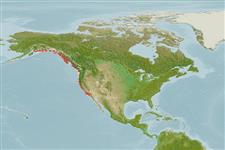分类 / Names
俗名 | 同种异名 | Catalog of Fishes(属, 种) | ITIS | CoL | WoRMS | Cloffa
Chondrostei >
Acipenseriformes (Sturgeons and paddlefishes) >
Acipenseridae (Sturgeons) > Acipenserinae
Etymology: Acipenser: Latin, acipenser = sturgeon, 1853 (Ref. 45335); medirostris: The specific name is derived from medirostris, referring to its moderate snout (Ref. 1998).
More on author: Ayres.
Environment: milieu / climate zone / depth range / distribution range
生态学
海洋; 淡水; 半咸淡水 居于水底的; 溯河洄游 (Ref. 120652); 深度上下限 0 - 80 m (Ref. 50610). 温带; 10°C - 20°C (Ref. 2059); 65°N - 32°N, 166°W - 114°W (Ref. 54261)
North America: Aleutian Islands and the Gulf of Alaska to Ensenada, Mexico. Considered vulnerable in Canada. The Asian population is now considered to be a separate species Acipenser mikadoi (Ref. 6866).
北美洲: 阿留申群岛与阿拉斯加湾到墨西哥思胜那达。 被认为是易受伤害的在加拿大。 亚洲族群现在被认为是是一个个别的种 米氏鲟〔Acipenser mikadoi〕 。 (参考文献 6866) 国际间的买卖限制 ( CITES2, 自从 1.4.98 以后; CMS 附录 2).
Length at first maturity / 大小 / 重量 / 年龄
Maturity: Lm ?, range 162 - ? cm
Max length : 270 cm TL 雄鱼/尚未辨别雌雄; (Ref. 96339); common length : 130 cm TL 雄鱼/尚未辨别雌雄; (Ref. 12193); 最大体重: 159.0 kg (Ref. 2850); 最大年龄: 60 年 (Ref. 72476)
背棘 (总数) : 0; 背的软条 (总数) : 33 - 35; 臀棘: 0; 臀鳍软条: 22 - 28. Characterized by a single row of 1 to 4 bony plates along the midventral line between the anus and the anal fin, and about 33 to 35 rays in the dorsal fin. Dorsal arises at posterior third of the total length; anal fin arises under posterior part of dorsal; pectorals originate low on the body just behind gill opening and are large and rounded; pelvic fins arise near the anus. Generally olive to dark green, lower parts more or less whitish green; a longitudinal olive-green stripe on side between lateral and ventrolateral plates, another on midventral surface; fins grayish to pale green (Ref. 27547). Barbels usually situated closer to mouth than to snout tip; coloration of scutes along side paler than skin (Ref. 86798).
特徵为一个单列的 1 到 4个骨质板沿着在肛门与臀鳍之间的腹部中央的线, 在背鳍中大约 33 到 35个鳍条。 背部的出现在全长的后面三分之一; 臀鳍出现在较后面的部分下面背部的; 胸鳍起点在身体在鳃裂正后方而且是大而圆形的上低处; 腹鳍在肛门的附近出现。 通常橄榄色到深绿色的, 下部约略白绿色的; 在侧面的和腹侧的碟之间的侧边上的一条纵向的橄榄绿色的斑纹,另一个在腹部中央的表面上; 鳍浅灰色的到灰绿色.(参考文献 27547)
Found in estuaries, lower reaches of large rivers, and in salt or brackish water off river mouths (Ref. 5723). Probably spawns in fresh water (Ref. 27547). May cover considerable distances in the ocean (Ref. 27547). Edible but with a disagreeable taste and unpleasant odor (Ref. 1998).
发现于河口,大河的下游了, 与在盐或半淡咸水河口外中.(参考文献 5723) 可能在淡水中产卵。 (参考文献 27547) 在海洋中可能包含相当多的距离。 (参考文献 27547) 可食用的但是有一个不愉快的品尝与不愉快的气味.(参考文献 1998)
北美洲: 阿留申群岛与阿拉斯加湾到墨西哥思胜那达。 被认为是易受伤害的在加拿大。 亚洲族群现在被认为是是一个个别的种 米氏鲟〔Acipenser mikadoi〕 。 (参考文献 6866) 国际间的买卖限制 ( CITES2, 自从 1.4.98 以后; CMS 附录 2).
Page, L.M. and B.M. Burr, 1991. A field guide to freshwater fishes of North America north of Mexico. Houghton Mifflin Company, Boston. 432 p. (Ref. 5723)
世界自然保护联盟红皮书 (Ref. 130435)
濒危 (EN) (A2bc); Date assessed: 14 September 2019
人类利用
渔业: 低经济; 游钓鱼种: 是的
工具
特别资料
下载 XML
网络资源
Estimates based on models
Preferred temperature (Ref.
123201): 9.1 - 12.7, mean 10.6 °C (based on 50 cells).
Phylogenetic diversity index (Ref.
82804): PD
50 = 0.5000 [Uniqueness, from 0.5 = low to 2.0 = high].
Bayesian length-weight: a=0.00324 (0.00142 - 0.00736), b=3.17 (2.99 - 3.35), in cm total length, based on LWR estimates for this Genus-body shape (Ref.
93245).
营养阶层 (Ref.
69278): 3.5 ±0.52 se; based on food items.
Generation time: 12.6 ( na - na) years. Estimated as median ln(3)/K based on 1
growth studies.
回复力 (Ref.
120179): 低的, 最小族群倍增时间4.5 - 14 年 (K=0.05-0.09).
Fishing Vulnerability (Ref.
59153): Very high vulnerability (80 of 100).
Climate Vulnerability (Ref.
125649): High to very high vulnerability (67 of 100).
Nutrients (Ref.
124155): Calcium = 14.8 [9.0, 24.9] mg/100g; Iron = 0.253 [0.156, 0.390] mg/100g; Protein = 17.7 [15.1, 20.3] %; Omega3 = 0.354 [0.202, 0.615] g/100g; Selenium = 22.6 [12.6, 42.8] μg/100g; VitaminA = 4.61 [1.77, 11.95] μg/100g; Zinc = 0.437 [0.320, 0.597] mg/100g (wet weight);
